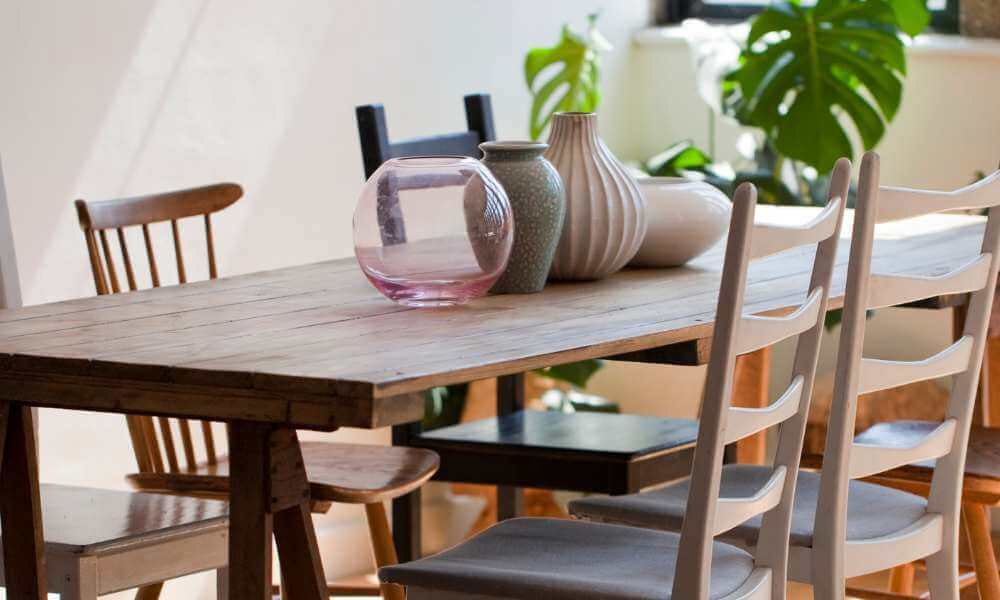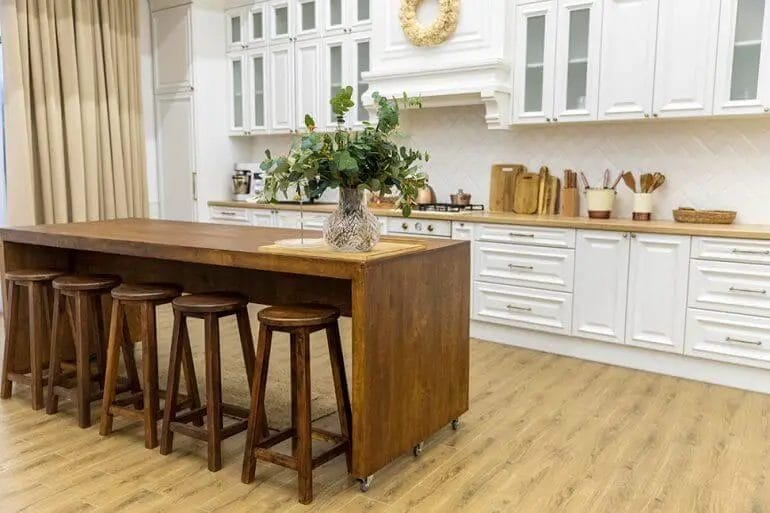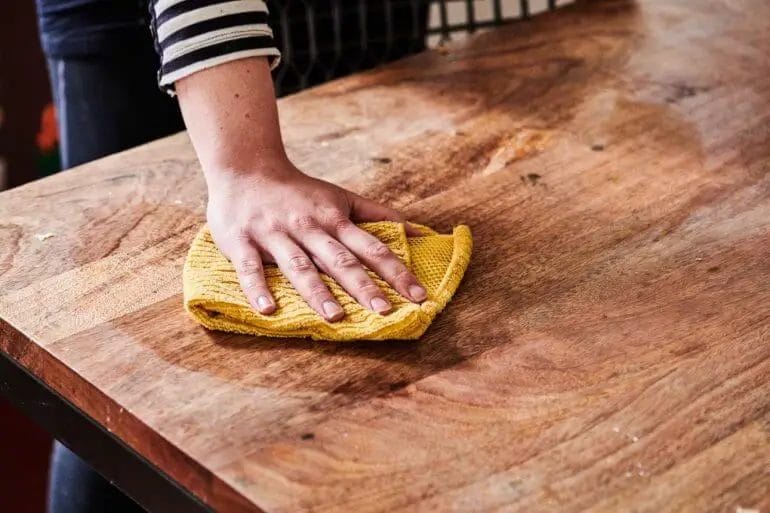If you want to ensure the longevity and beauty of your wood dining table, it’s essential to take the necessary steps to protect it. By implementing a few simple measures, you can guard against scratches, stains, and other potential damage. One effective method is to use table pads or tablecloths to provide a protective barrier during meals or gatherings.
Add coasters or placemats under hot dishes, plates, and glasses to prevent heat marks or water rings from forming on the table’s surface. Regular cleaning and maintenance are also key in keeping your wood dining table in excellent condition. Use a mild cleaner specifically designed for wood and avoid using abrasive materials that could scratch or damage the finish.

Another precautionary step is to keep your table away from direct sunlight or extreme temperature fluctuations, as these can cause the wood to warp or fade over time. Consider placing your table in a location that is not exposed to these factors. Lastly, for added protection, apply a quality wood sealer or wax to maintain the wood’s natural beauty and shield it from moisture.
By following these tips, you can effectively protect your wood dining table and enjoy its elegance and functionality for years to come.

Essential Tips for Maintaining the Beauty and Integrity of Your Wood Dining Table
Having a beautiful wood dining table can be a great addition to any home. Not only does it provide a functional space for meals and gatherings, but it also adds an element of elegance and warmth to your dining area. To ensure that your wood dining table remains in top condition for years to come, here are some essential tips to help you maintain its beauty and integrity.
1. Clean Regularly
Regular cleaning is essential for keeping your wood dining table looking its best. Use a soft cloth or microfiber duster to gently remove dust and debris from the surface. Avoid using abrasive cleaners or rough materials that can scratch the wood. Instead, opt for mild soapy water or a specialized wood cleaner recommended by the manufacturer. Always follow the grain of the wood when cleaning to prevent damage.
2. Protect from Heat and Moisture
Wood is sensitive to extreme temperatures and moisture. To protect your dining table, use coasters, placemats, and trivets to prevent hot dishes, beverages, and wet materials from directly contacting the surface. Wipe up any spills immediately to avoid moisture penetration and potential staining. Additionally, avoid placing your table near direct heat sources such as radiators or fireplaces, as this can cause the wood to warp or crack.
3. Apply a Protective Finish
A protective finish can help shield your wood dining table from daily wear and tear. Consider applying a layer of wax, varnish, or polyurethane to create a barrier against stains, scratches, and moisture. Follow the manufacturer’s instructions for application and ensure proper ventilation during the process. Regular maintenance of the protective finish may be required, such as reapplying wax or applying a fresh coat of varnish.
4. Avoid Direct Sunlight
Prolonged exposure to direct sunlight can fade and damage the finish of your wood dining table. Consider placing your table away from windows or using curtains, blinds, or UV-blocking films to minimize sun exposure. If it’s not possible to relocate the table, rotate decorative items such as centerpieces or tablecloths regularly to prevent uneven fading.
5. Use Table Pads and Tablecloths
To provide an extra layer of protection, consider using table pads or tablecloths on your wood dining table. These accessories can help guard against spills, scratches, and heat damage. Opt for high-quality materials that are specifically designed for use with wood furniture, and clean them regularly according to the manufacturer’s instructions.
6. Avoid Sharp Objects and Heavy Items
Avoid placing sharp objects directly on the surface of your wood dining table to prevent scratches and dents. Use coasters or protective mats under items such as vases, decorative objects, or serving utensils with sharp edges. Similarly, avoid placing heavy items or applying excessive pressure on specific areas of the table, as this can cause the wood to warp or crack over time.
7. Regularly Inspect and Repair
Regularly inspect your wood dining table for any signs of damage, such as loose joints, cracks, or chips. Address any issues promptly to prevent further deterioration. Depending on the severity of the damage, you may need to consult a professional furniture repair specialist for repairs or refinishing.
8. Maintain the Right Humidity Levels
Wood is sensitive to changes in humidity, which can cause it to expand or contract. Maintain a stable indoor humidity level between 40% and 45% to minimize the risk of warping or cracking. Use a humidifier or dehumidifier if necessary, especially in environments with extreme humidity fluctuations.
In summary, caring for your wood dining table involves regular cleaning, protection from heat and moisture, applying a protective finish, avoiding direct sunlight, using table pads and tablecloths, being mindful of sharp objects and heavy items, regularly inspecting and repairing, and maintaining the right humidity levels. By following these essential tips, you can ensure that your wood dining table retains its beauty and integrity for years to come.

Environmental Factors to Consider for Long-lasting Wood Dining Table Protection
A wood dining table is not just a piece of furniture; it is an investment that adds warmth and elegance to your home. However, to ensure its longevity, it is vital to consider the environmental factors that can impact its protection. By understanding and addressing these factors, you can keep your wood dining table looking beautiful for years to come.
1. Temperature and Humidity
Wood is a natural material that expands and contracts with fluctuations in temperature and humidity. Extreme changes in these factors can lead to warping, cracking, or splitting of the wood. To protect your dining table, it is crucial to maintain a consistent temperature and humidity level in your home.
Use a hygrometer to measure the humidity levels in your dining area. Ideally, the humidity should be between 40% to 45%. If the humidity is too high, use a dehumidifier to reduce moisture. If the humidity is too low, consider using a humidifier to add moisture to the air.
Avoid placing your wood dining table near heat sources such as radiators or fireplaces, as the direct heat can cause the wood to dry out and warp. Instead, position the table in an area away from direct sunlight and heat sources.
2. Sunlight Exposure
Prolonged exposure to sunlight can cause the wood to fade and discolor over time. UV rays from the sun can damage the finish and make the table look dull. To protect your dining table from sunlight:
- Use curtains, blinds, or UV-blocking window films to limit direct sunlight exposure.
- Rotate the table periodically to ensure even exposure to sunlight.
- Apply a protective coating or use a tablecloth when the table is not in use.
3. Spills and Stains
Accidents happen, and spills are inevitable. However, it is essential to address spills immediately to prevent permanent stains on your wood dining table. Here are some tips for handling spills:
- Blot the spill with a clean cloth or paper towel to absorb the liquid.
- Wipe the area gently with a damp cloth to remove any remaining residue.
- Dry the surface thoroughly to prevent moisture from seeping into the wood.
- If a stain persists, use a mild wood cleaner or a mixture of vinegar and water to clean the affected area.
4. Regular Cleaning and Maintenance
To maintain the beauty of your wood dining table, regular cleaning and maintenance are essential. Here are some tips:
- Dust the table frequently using a soft, lint-free cloth to remove any loose particles.
- Avoid using abrasive cleaners or harsh chemicals that can damage the wood finish.
- Apply a high-quality wood polish or wax to protect and nourish the wood.
- Use coasters, placemats, or tablecloths to prevent scratches and heat marks from hot dishes or utensils.
- Inspect the table regularly for any signs of wear or damage and address them promptly.
In summary, protecting your wood dining table from environmental factors is crucial for its long-lasting beauty and durability. By maintaining proper temperature and humidity levels, limiting sunlight exposure, addressing spills promptly, and practicing regular cleaning and maintenance, you can ensure that your dining table remains a centerpiece in your home for years to come.

DIY Wood Dining Table Protection: Natural and Eco-friendly Solutions
Wooden dining tables add warmth and elegance to any home. However, they are also susceptible to damage from spills, heat, and everyday wear and tear. To keep your wood dining table looking beautiful for years to come, it’s important to provide proper protection. While there are many commercial products available, they often contain harsh chemicals that can be harmful to your health and the environment. Luckily, there are several natural and eco-friendly solutions you can try to protect your wood dining table.
1. Beeswax Polish
Beeswax polish is a fantastic natural solution to protect your wood dining table. It creates a protective barrier on the surface of the wood, preventing moisture from seeping in and causing damage. To make your own beeswax polish, melt 1 cup of beeswax pellets in a double boiler. Once melted, stir in 1/4 cup of olive oil or coconut oil. Allow the mixture to cool, but not solidify completely. Then, apply a thin layer of the polish to the table using a soft cloth or sponge. Let it sit for a few minutes, then buff it off with a clean cloth. The beeswax polish will leave your wood table with a beautiful, natural shine.
2. Vinegar and Olive Oil Solution
An easy and effective way to protect your wood dining table is by using a vinegar and olive oil solution. Mix equal parts white vinegar and olive oil in a spray bottle. Shake well to combine. Spray a small amount of the solution onto a soft cloth and gently rub it onto the table surface, following the direction of the wood grain. The vinegar helps to clean and remove dirt, while the olive oil moisturizes and protects the wood. This solution is particularly useful for removing water stains and restoring the natural luster of the wood.
3. Citrus Oil Cleaner
Citrus oil cleaners are not only natural and eco-friendly, but they also leave your wood dining table smelling fresh and citrusy. To make your own citrus oil cleaner, combine the zest of one lemon, one orange, and one grapefruit with 2 cups of white vinegar in a glass jar. Seal the jar and let it sit for at least two weeks to infuse. After two weeks, strain the mixture and transfer it to a spray bottle. Spray the citrus oil cleaner onto a soft cloth and wipe down your wood table. The citrus oil will help to remove dirt and grime, while also protecting the wood from drying out.
4. Tablecloth and Placemats
Prevention is always better than cure when it comes to protecting your wood dining table. Using tablecloths and placemats can be a great way to shield your table from spills, scratches, and heat damage. Opt for natural and eco-friendly materials like cotton or linen for the tablecloth and placemats. Make sure to clean and wash them regularly to avoid any build-up of dirt or stains that could transfer onto the table.
Summary
Maintaining the beauty and longevity of your wood dining table is essential. By using natural and eco-friendly solutions like beeswax polish, vinegar and olive oil solution, citrus oil cleaner, and incorporating tablecloths and placemats, you can protect your table from damage while also maintaining a healthier environment. These DIY methods are not only effective but also safer alternatives to commercial products. Give these natural solutions a try and enjoy a beautiful and protected wood dining table for years to come.
5. Protecting Your Wood Dining Table from Accidental Spills and Scratches
Having a beautiful wood dining table can be the centerpiece of your dining room, but it also requires proper care and protection to maintain its beauty and longevity. Accidental spills and scratches can easily damage the surface of your table, so it’s important to take preventive measures to keep it looking its best. Here are some tips to help you protect your wood dining table:
1. Use Tablecloths or Placemats
One of the easiest ways to protect your wood dining table from spills and scratches is by using tablecloths or placemats. These not only add a decorative touch to your table setting, but also provide a barrier between the table surface and any potential damage. Opt for tablecloths or placemats made from materials that are water-resistant and easy to clean, such as vinyl or laminated fabric.
2. Use Coasters and Trivets
When serving hot or cold beverages, it’s important to use coasters to protect the table from heat and condensation. Placing hot or cold items directly on the wood surface can result in unsightly heat marks or water rings. Similarly, when serving hot dishes or pots, use trivets to provide a heat-resistant barrier between the hot cookware and the table.
3. Clean Spills Immediately
Accidental spills are bound to happen, but it’s crucial to clean them up as soon as possible to prevent any liquid from seeping into the wood. Use a soft cloth or paper towel to blot the spill gently, rather than rubbing it, which can spread the liquid and potentially damage the finish. After cleaning, dry the area thoroughly to avoid any moisture lingering on the surface.
4. Avoid Harsh Cleaners
When it comes to cleaning your wood dining table, avoid using harsh chemical cleaners or abrasive materials. These can strip away the protective finish and damage the wood. Instead, opt for mild soap or a specially formulated wood cleaner. Apply the cleaner to a soft cloth and gently wipe the surface, following the direction of the wood grain.
5. Use Protective Pads or Felt Bottoms
To prevent scratches from everyday use, consider using protective pads or felt bottoms on the bottom of items that will come into direct contact with the table. This includes chair legs, vases, and other decorative objects. These pads provide a cushioned barrier that helps to prevent scratches and dents.
6. Regularly Dust and Polish
Maintaining a regular cleaning routine is essential to keep your wood dining table in top condition. Dust the surface regularly with a soft, lint-free cloth to remove any dirt or debris. Additionally, use a high-quality wood polish to nourish and protect the wood. Apply the polish in a circular motion, following the wood grain, and buff to a shine.
7. Consider Protective Covers
If you have young children or frequently host large gatherings, it may be worth investing in protective covers for your wood dining table. These covers provide an extra layer of protection against spills, scratches, and other accidental damage. They can be easily removed when not in use, allowing you to showcase the natural beauty of your table.
In summary, protecting your wood dining table from accidental spills and scratches is essential to maintain its appearance and durability. By using tablecloths or placemats, coasters and trivets, cleaning spills immediately, avoiding harsh cleaners, using protective pads or felt bottoms, regularly dusting and polishing, and considering protective covers, you can ensure that your wood dining table remains a stunning focal point in your dining room for years to come.
FAQs
Q: How can I protect my wood dining table?
To protect your wood dining table, you can follow these steps:
1. Use coasters or placemats to prevent stains and heat damage.
2. Clean up spills immediately to avoid moisture damage.
3. Avoid placing hot objects directly on the table.
4. Regularly dust and clean the table using a soft, damp cloth.
5. Apply a protective finish or wax to enhance the table’s durability.
6. Keep the table away from direct sunlight and extreme temperature changes.
Conclusion
In conclusion, protecting your wood dining table is essential for maintaining its beauty and longevity. By following a few simple steps, you can ensure that your table remains in pristine condition for years to come. Regularly dusting and cleaning your table with gentle, non-abrasive products will prevent dirt and debris from causing scratches or stains. Furthermore, using a protective tablecloth or placemats during meals will shield the surface from spills and heat damage. Applying a high-quality wood polish or sealant on a regular basis will also help to keep the wood moisturized and protected from drying out or fading.
Remember to avoid placing your table in direct sunlight or near sources of extreme heat or humidity, as these factors can cause warping or discoloration. Lastly, handle your table with care and avoid excessive force or weight to prevent any accidental damage. By implementing these measures, you can enjoy your wood dining table’s beauty and functionality for many years to come.